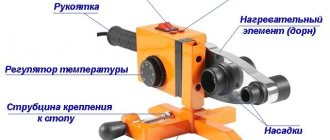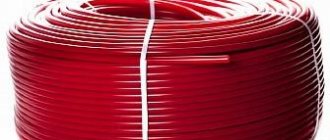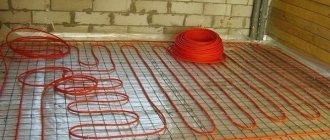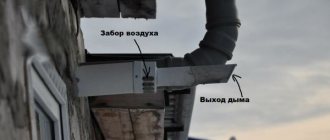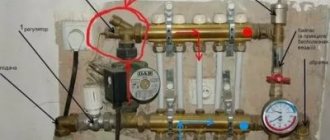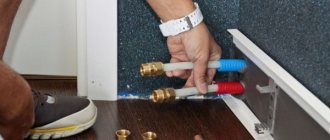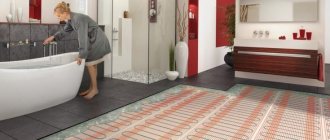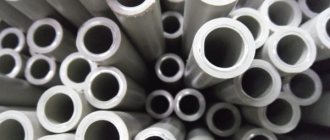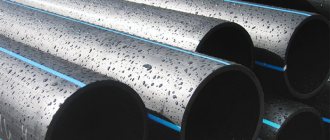Heating a house with warm water floors is not uncommon today, and increasingly this system is preferred when choosing a heating method.
The design of water floors consists of pipes laid in the floor with a coolant moving inside (usually water). The system is connected to central heating, hot water supply or a specially equipped boiler.
There are many types of pipes that can be installed in the construction of heating floors; today we will talk about polypropylene.
Types and characteristics of polypropylene pipes
Polypropylene pipes are widely used in the construction industry, as they are inexpensive and quite durable.
They are available in two types: single-layer and multi-layer. Each type has its own positive and negative sides. Let's look at them.
Single layer
Single-layer polypropylene contours come in several varieties:
- RPH - made of homopropylene. They are not intended for heated floors, but are widely used in water supply, sewerage and ventilation systems.
- PPB - made from polypropylene block copolymer. Products of this type are durable and resistant.
- PPR - random copolymer polypropylene is used in production. The contour of it evenly distributes the load along its walls.
- PPS - this product is flame retardant. Pipes are able to work efficiently even when heated to +95 degrees.
Multilayer
Multilayer polypropylene pipes are also available in several types and have the following technical characteristics:
- Aluminum - the pipeline has a thin reinforcing layer on the outside. In the process of connecting such elements, the aluminum layer is cut off by 1 mm. There are products where the reinforcement is between the walls. Polypropylene pipes with a reinforcing layer function effectively even at + 95 degrees.
- Fiberglass - reinforcement is located between sheets of polypropylene. This type works great in the construction of warm floors.
- Composite - between two layers of polypropylene there is a layer that combines fiberglass and aluminum fibers.
Technological difficulties
Hot polypropylene expands in volume. This property of polypropylene pipes is clearly visible on long outdoor pipelines. It does not disappear when polypropylene pipes are embedded in a cement screed for a heated floor.
Hardened concrete interferes with the movement of heated plastic. As a result, when operating underfloor heating, polypropylene pipes experience excessive bursting loads. A leak in such a situation is not guaranteed, but it is likely.
Advantages and disadvantages of polypropylene
The main reason for the popularity of PPR pipes in the construction of heated floors is cost-effectiveness. Their cost is affordable, and this is especially important when installing a pipeline over a large area.
In addition, polypropylene contours:
- have increased mechanical strength and elasticity;
- have an excellent level of tightness - this is ensured by a special soldering method, the product is monolithic, almost seamless, which allows you to place pipes under a screed;
- durable - if installation rules are followed, they will last for several decades without an accident;
- are light in weight - this makes the installation process simple;
- inert - not susceptible to aggressive substances;
- are not subject to corrosion - thus, deposits do not accumulate inside the pipe;
- have good sound insulation;
- environmentally friendly - no harmful substances are released when heated.
Polypropylene is highly resistant to low temperatures, which protects the coolant from freezing.
But even if it freezes, the walls of the pipes are not destroyed, since the polymer is able to expand, and when heated, returns to its original shape. Therefore, polypropylene pipes are ideal for installation in country cottages where the owners do not live permanently and the floor is used occasionally.
However, this type of pipe rolling materials also has disadvantages. Polypropylene is highly flammable and should not be installed in rooms with a high level of fire hazard (wooden). In addition, the optimal operating temperature limit is + 75 degrees. It is worth saying that the PP has poor flexibility, and it will not be possible to make turns within a small radius.
In addition, ordinary PVC pipes are intended for use in water supply and sewerage systems, but they cannot be placed in heated floors, as they will not withstand thermal and hydraulic loads. Therefore, it is necessary to lay a reinforced contour in heated floors.
Pipes for heated floors. Recommendations from experts // FORUMHOUSE
Advantages
To lay a heated floor in a cement screed, polypropylene is chosen as the material from which the pipes are made for a number of reasons:
- Polypropylene, unlike a number of other materials, lies well in a cement screed and has particular strength and durability.
- Warm floors with polypropylene pipes are cheaper than warm floors made from other materials.
- Unlike products made of metal-plastic, it tolerates temperature changes well and does not burst when frozen.
- Light weight is an advantage when transporting and working with them.
- No corrosion.
- They lie well in the screed, while metal-plastic products cannot be rolled into concrete.
- High heat transfer efficiency.
- Polypropylene pipes can operate for up to 50 years without loss of quality.
There are also disadvantages to using:
- They cannot be used in areas with a high fire hazard. The optimal operating temperature for them is 75°C. Maximum - 95°C.
- Unlike a number of others, they bend poorly, which is why laying them in increments of less than 13 centimeters is problematic. However, larger spacing is usually used when laying.
- It is necessary to use reinforced pipes, since single-layer pipes in the screed can be severely deformed.
- Installation is not possible in harsh climatic conditions, since the coolant temperature in those places is over 110°C.
Polypropylene is one of the recommended materials for underfloor heating in concrete screed; it is often chosen as a material with which you can work independently. Below we describe in detail how to make a warm floor in a concrete screed from polypropylene pipes.
Structure of polypropylene pipe
- long service life of a warm water floor. Polypropylene pipes can work effectively for 50 years;
- polypropylene has high chemical resistance;
- Such pipes are not subject to corrosion. Scale does not accumulate on their inner surface;
- such pipes have a low noise level;
- The individual elements of the system are interconnected monolithically.
This ensures its long service life, since coolant leaks are eliminated; Characteristics of polypropylene pipes - installation of polypropylene pipes occurs using a special welding machine. Any person without relevant experience can work with it;
- polypropylene provides high oxygen impermeability. This allows you to extend the service life of all metal parts that will not be subject to corrosion;
- The price of polypropylene pipes is good.
Additional parts for installing the entire system (fittings and others) are also low in cost; Service life of polypropylene pipes of different types with temperature and pressure indicators - polypropylene is highly durable. It is able to work effectively in the presence of high pressure from the circulating coolant;
- light weight, which ensures ease of installation;
- When the coolant freezes, the walls of the pipelines do not collapse. They are able to expand and, after increasing temperature, take their original shape;
- polypropylene is considered environmentally friendly. It does not emit toxic substances during operation.
When using polypropylene pipes for underfloor heating, it is necessary to use elements with reinforced walls. The use of conventional materials will reduce the service life of the system. Unreinforced walls cannot cope with the high load from circulating coolant under pressure. Also, a certain impact is observed from the screed and other elements of the heated floor.
How to install polypropylene pipes
Another disadvantage of polypropylene is its instability to high temperatures. Therefore, it is prohibited to use it in areas with a high fire hazard. The normal operating temperature of polypropylene is considered to be 75°C (pressure up to 7.5 atm.). It can be operated at 95°C, but in this case the service life is significantly reduced. Therefore, when installing an underfloor heating system, care must be taken to ensure that the coolant reaches the optimal temperature.
Polypropylene pipes are popular for installing heated floors, water supply systems and other utility networks in the house. They can be single-layer or multi-layer. Each option has its own scope of application.
Polypropylene pipes for water supply and heating systems
Single layer
Size chart of single-layer polypropylene pipes
- RRN. Pipelines are made of homopolypropylene. Not used for underfloor heating, but widely used for water supply and ventilation systems;
- RRV. Made from polypropylene block copolymer. They are distinguished by high strength and durability;
- PPR. Random copolymer polypropylene is used for production. Pipes made of this material are able to effectively distribute the generated load along their walls;
- PPs. Pipes of this type are highly flammable. They are able to work effectively at temperatures that do not exceed 95°C.
Multilayer
Technical characteristics of multilayer polypropylene pipes
- aluminum A thin reinforcing sheet is applied to the outer surface of the pipeline. When connecting several elements, the aluminum layer is cut off by 1 mm. There are also variations where reinforcement is carried out inside - between the walls. Polypropylene pipes with aluminum reinforcement can operate effectively at a temperature of 95°C (short-term at 110°C);
- fiberglass. The reinforcing layer is placed between sheets of polypropylene. These pipelines are effective for installing underfloor heating;
- composite A mixture of aluminum and fiberglass fibers is laid between two layers of polypropylene.
Just 5-10 years ago, heated floors could easily be called an expensive pleasure. Water heating, which uses underfloor heating, was considered a luxury item. This heating method was in most cases installed in luxury housing.
Today the situation has changed radically. Watery floors are becoming commonplace. An increasing number of consumers prefer this option for heating residential premises.
The main reason for the popularity of warm water floors is their efficiency, affordable price and high efficiency.
You can always choose materials that match the technological parameters of the heating system and your personal requirements for this heating method.
If the equipment included in the pumping and mixing unit for underfloor heating is a separate discussion, then the pipes deserve special attention.
Despite the fact that today the choice of consumables is quite large, preference is given to the option when the heated floor is made from polypropylene pipes. Why? Let's look into the details.
Main article about polypropylene pipes.
Let's start with the fact that underfloor heating can be used as the main heating option in a living space or act as an additional heat source.
Depending on the technological characteristics of the residential building, it is up to you to decide which heating option to use in the case of heated floors. For an apartment in an apartment building, a warm floor may be an exception.
In some cases, residents try to use a heated tiled surface to increase comfort in the bathroom or other technological areas.
In a situation when it comes to installing a heating system “warm floors” in a private house, there are no prohibitions or obstacles to the implementation of the project. It is possible to carry out the installation and installation of heated floors of any size in various combinations.
For those who have decided to install heated floors in their home, it is important to know about the necessary equipment and consumables. Pipes for any water heating system are the main working element. It is through them that the prepared water circulates, transferring thermal energy to heating sources.
Important
These can be radiators or, in the case of water floors, a heated concrete screed, or a stacked wooden floor structure. The transfer of thermal energy from the floor surface coolant is carried out through water heating circuits.
READ MORE: Cork laminate flooring features and how to install it
What material the water loop pipe is made of depends on the speed of installation of the in-floor pipeline and the quality of heating the floor surface.
Today, manufacturing companies are ready to offer consumables for every taste. It all depends on the financial capabilities of the consumer. On the practical side, the following types of pipes can be used for underfloor heating equipment:
- copper;
- corrugated, metal;
- metal-plastic;
- consumable material made of cross-linked polyethylene;
- polypropylene.
Any option has the right to be implemented, but here the factor of efficiency and technological feasibility comes into play. In this aspect, polypropylene pipes look preferable in many respects. Why do many consumers today prefer consumables made from polypropylene?
Warm floors made of polypropylene pipes are currently the most common option. It's all about the price. When installing large-scale heating systems, when it comes to water floors with a total pipeline length of several hundred meters, the economic component comes to the fore. In this regard, polypropylene heating circuits are a good solution to the problem.
The advantages of such consumables include the following parameters:
- the necessary mechanical strength and elasticity of polypropylene pipes;
- necessary tightness of connections;
- durability;
- high technological characteristics that simplify the installation of heating circuits;
- low cost.
There are a couple of points to make here. Polypropylene is highly resistant to low temperatures. Freezing of the coolant in the pipeline will not lead to mechanical damage to the heating circuit. This pipe is perfect for heated floors installed in country houses and country houses where the heating system operates periodically.
Polypropylene does not enter into chemical reactions with concrete, therefore it does not oxidize or deteriorate over time
When using fittings for corner joints of pipes, a soldering iron is not useful
Main types
Marking of polypropylene pipes
Currently, there is a wide variety of products in this segment on the market, which are labeled as follows:
- PN 10 - installed on ordinary polypropylene pipes with a homogeneous structure. They are recommended for use in water supply systems with water temperatures up to 20 degrees and pressure up to 10 atm. Pipes with this marking usually have a diameter from 20 to 110 mm.
- PN 16 - designates a single-layer product that is suitable for installation in warm water floors. Let's allow the coolant to heat up to 80 degrees and pressure up to 10 atm. The diameter of the contours is the same as PN 10, but the thickness of the walls is much greater.
- PN 20 - marking of homogeneous pipes; they have a permitted heating level of the circulating coolant up to + 95 degrees. The working pressure in this case is no more than 6 atm, and the diameter is from 20 to 110 mm.
- PN20 AL (PN20 GF) - installed on polymers with an aluminum reinforcing layer or fiberglass. The remaining indicators coincide with PN 20. This type differs from other consumables in the coefficient of thermal expansion - it is smaller.
It is very important to take this marking into account when choosing a product for certain operating conditions; the efficiency of the heated floor depends on it.
Creating a diagram and calculating the number of pipes
Before starting work on installing a heated water floor made of polypropylene, you need to prepare a project and calculate everything.
Warm floor made of polypropylene.
The drawing is made on graph paper, it reflects the layout and installation step.
Project preparation
The water heated floor pipeline can be laid according to the following schemes:
- “Snake” is a simple option, but has a drawback - the coolant cools down as it passes through the pipe, and in the end it will be colder.
- “Spiral” - with this method, heating is uniform, which is why it is more popular.
- “Double snake” - in this case the heat is distributed evenly over the floor surface.
When choosing a scheme, the degree of heat transfer of the structure is taken into account, since the efficiency of the floor will depend on this. To do this, you will need to know: the area of the room, the material from which the walls, ceilings and thermal insulation are made, the type of flooring, the diameter of the circuit and its material, the temperature of the coolant.
After choosing a laying pattern, it needs to be applied to paper. It is recommended to make the step between the pipes from 10 to 30 cm, and the length of the loop is no more than 80 meters. The contour is laid at a distance of 20 cm from the walls. The installation location of the manifold cabinet should be noted on the drawing.
If warm water floors are used as the main heating, then the pipeline should be laid in increments of 12-15 cm.
Pipe sizing calculation
To determine the footage of polypropylene pipes for heated floors, two methods are used. One is to measure the size of the pipeline on the drawing with a ruler, and then multiply this indicator by the appropriate scale. A margin of 10% for pruning is added to the result obtained.
The second way is using thread. A thread is placed on the floor according to the contour laying pattern. Then, you just need to measure it - this will be the size of the pipeline. Just as in the first case, you need to add 10% of the reserve.
For each room, the length of the pipes must be calculated separately.
Preparatory work before installing the system
For the correct installation of a warm water floor “pie” made of polypropylene pipes, preparatory work should be carried out. Step by step, the actions look like this:
- The old floor covering is removed and the screed is dismantled.
- The foundation is assessed and if cracks are found, they must be repaired. But first, you should clean the surface from concrete chips and apply a primer. If the subfloor cannot be reconstructed, a thin layer of leveling screed must be poured.
- The manifold cabinet is installed on the wall or in a specially equipped niche, at a distance of 1 meter from the floor. This must be done before laying the floor “pie”, since the installation process is quite messy.
- A waterproofing layer is laid, thick polyethylene is suitable, it is able to retain moisture. The film needs to be laid with an overlap of 10 cm on the walls. If the area of the room is large and several strips of film are laid, then they overlap, and they can be connected to each other with tape.
- A damper tape is glued around the perimeter so that the concrete screed does not crack when heated.
- Thermal insulation is installed. It is possible to lay different materials - roll or sheet. When choosing extruded polystyrene foam boards, there should be no gaps between them, so the material should be laid in two layers. For greater tightness, the joints can be sewn with polyurethane foam.
- A foil backing is laid down; it is necessary to reflect heat rays. The heat is directed upward, thereby heating the floor and the air in the room. The material is connected using adhesive tape. If the thermal insulation material has a foil layer, then this substrate is not needed.
- A reinforcing mesh is placed to add strength to the structure, and a pipeline can also be attached to it.
Strict adherence to all rules for carrying out this work contributes to the efficient operation of the system.
Preparatory work for laying a warm water floor
During the preparatory work, it is necessary to take into account all the little things that, directly or indirectly, can subsequently affect the efficiency of the structure. In particular, in order for a warm floor made of polypropylene pipes to heat the air in the room, and not the base located under the system, it is necessary to provide thermal insulation. It is done with your own hands in several stages:
- Place a layer of waterproofing on the rough screed. A thick plastic film is suitable for this. When performing work in a private house, wrap it onto the wall by 100 millimeters. This way you will limit the penetration of moisture rising from the ground onto the underfloor heating elements.
- the next stage is laying thermal insulation material. In most cases, extruded polystyrene foam is used as such. Perform installation in a staggered manner. If the rough screed is uneven, cracks may form at the joints of the slabs. They can be filled with polyurethane foam. Perform the same operation with the gaps between the polystyrene foam boards and the wall.
Before laying pipes, you need to cover the floor with a layer of insulating material
Polypropylene pipes have high stability and long service life in concrete screed
Heating of the room occurs due to the circulation of coolant in a circuit placed in a concrete floor screed. Water is heated in a heating boiler connected to the system. The movement of liquid along a closed circuit is ensured by a circulation pump. The heated floor scheme also includes a distribution manifold, shut-off valves, and fittings.
The base of the floor is insulated and waterproofed before installation. After laying, connecting and checking the system, the pipes are filled with concrete screed. Heat is evenly distributed throughout the entire thickness of the formation, accumulated and transferred to the room. This is the best option, heating the house using the convection principle.
Warm water floors are usually installed in private homes. Systems are not prohibited in apartments, but residents encounter some difficulties when installing them.
- soldering iron for plastic with attachments;
- pipe cutting scissors;
- roulette;
- building level;
- drill.
To prepare the concrete solution, it is advisable to use a concrete mixer.
The base base for the heating system must be horizontal. If there are significant differences in height, a concrete screed is poured. The structure is covered with a layer of waterproofing. The most practical option is plastic film. A damper tape is glued around the perimeter of the room to compensate for the expansion of concrete.
First of all, a collector is mounted to which the circuits will be attached
Before installation begins, a distribution manifold with a valve and valves is installed. An outline will be attached to it. The pipes are laid on insulation or reinforcing mesh with 10x10 cm cells. The second option is more convenient and reliable. When working with polypropylene, it is important to observe the temperature regime. Installation is carried out in a warm room where the temperature is above 5°C.
The contour is laid out according to the intended pattern. Separate sections are connected with a soldering iron. Soldering produces a strong and airtight seam. Beginners are advised to perform several test welds to avoid damaging the pipeline. The pipes are secured to the reinforcing mesh with plastic clamps and wire. The fasteners must not be over-tightened.
Pressure testing is carried out for 3 days at double hydraulic load
After connecting the circuit to the distribution unit, the system is pressure tested. Water is supplied to the pipeline under pressure. The procedure helps to find poor-quality seams and cracks. The water is left for a day and the pressure parameters are monitored. If they are stable, the heated floor is assembled with high quality.
The final stage is pouring cement screed along the beacons. The solution is poured onto the floor and stretched using the rule. The optimal layer thickness is 5-7 cm. After the concrete has set, the beacons are removed and the holes are sealed with cement mortar. To ensure uniform drying, the screed is covered with film and watered for 14 days. The heated floor system is turned on after 1 month.
To ensure efficient operation of this heating system, compliance with the basic rules for laying circuits is required. Their total length should not be more than 80 m. For uniform heating, the optimal length is considered to be up to 50 m, the standard diameter is 2 cm. The calculation of the circuit and its step is carried out for each individual room, especially if they have different temperature conditions.
The process of laying heated floors
Pipe laying can be done using different schemes:
- spiral;
- double spiral;
- snake - loops;
- snail
The choice of a suitable scheme depends on the parameters of the room and the functional purpose of its zones. For example, a spiral circuit will ensure uniform heating of rooms that have the correct shape, while a snake is more suitable so that the hot coolant first gets into the cold zones, and then heats other parts of the room.
Spiral pipe laying
After laying the polypropylene pipes, they are secured with clamps to a metal reinforcing mesh. Then they are connected to the circuits, and the system is filled with water to check for leaks. The pressure in the system must be 1.5 times higher than the working pressure, but not less than 6 bar. Then the pressure is increased to the previous value every half hour at least 3 times, and then left for a day. If during this time the pressure does not drop by more than 2 bar, then the installation is done perfectly.
To install such a floor, it is necessary to lay pipes through which hot water will circulate, the source of which can be central heating or a separate boiler. One of the most common methods of installing a heated floor is a concrete heating system. All work can be divided into several stages: drawing up a project, preparing the floor, laying mesh and pipes, pouring concrete, laying the finishing coating.
Drawing up a project for future work is mandatory, especially if you plan to insulate floors over a large area. When designing, it must be taken into account what floors, walls and other elements are made of. This is necessary in order to calculate the desired temperature that should be in the room. Then you need to determine the installation location of the collector and boiler. Afterwards, you need to draw up a pipe layout diagram, indicate the length of the circuit and diameter, as well as other parameters.
READ MORE: Which is better, tiles or laminate in the kitchen: selection options
The heating water temperature must be set based on a calculation that takes into account the type of room, type of floor covering and outside design temperature. As a rule, the maximum temperature level for floor heating is 45 degrees with a water flow rate of 0.3 m/sec for smooth heat distribution.
It is impossible to make a warm floor with your own hands using polypropylene pipes if you do not properly prepare the base for their installation:
- At the first stage, waterproofing is laid.
To do this, it is recommended to use thick polyethylene film, which is not capable of allowing moisture to pass through. It is advisable to install waterproofing on the walls at a distance of 10 cm. Preparing the base before installing a warm water floor - Thermal insulation is being installed. You can use different insulation in the form of rolls or slabs. If extruded polystyrene foam is selected, care must be taken to ensure that no gaps form between the individual elements. They will become sources of cold air penetration. To do this, it is recommended to lay the insulation in two layers. The upper slabs must overlap the joints of the lower ones. To eliminate cold bridges, all cracks can be filled with polyurethane foam.
- A heat-insulating substrate with a foil coating is laid. Using penofol, you can significantly increase the efficiency of underfloor heating, since the generated heat will be reflected into the room. Scotch tape is used to seal the joints.
Welding of polypropylene pipes
To lay polypropylene pipes in a screed, it is recommended to use a “spiral” pattern. In this way, it is possible to ensure more uniform heating of the surface and facilitate installation. The pipes will be laid with a large radius, which is not the case when using the “snake” pattern.
To attach the water circuit, a metal mesh is laid on the prepared base. It will also strengthen the screed layer, which will last for a longer period. The pipes are attached to the mesh using metal wire or plastic clamps.
The installation of these elements should be done every 0.8 m. The fasteners should not be tightened too much, so as not to cause deformation of the pipes. They can also be fixed directly to the thermal insulation using dowels.
Polypropylene pipes for water heated floors
Advantages
- long service life of a warm water floor. Polypropylene pipes can work effectively for 50 years;
- polypropylene has high chemical resistance;
- Such pipes are not subject to corrosion. Scale does not accumulate on their inner surface;
- such pipes have a low noise level;
- The individual elements of the system are interconnected monolithically. This ensures its long service life, since coolant leaks are eliminated; Characteristics of polypropylene pipes
- installation of polypropylene pipes occurs using a special welding machine. Any person without relevant experience can work with it;
- polypropylene provides high oxygen impermeability. This allows you to extend the service life of all metal parts that will not be subject to corrosion;
- The price of polypropylene pipes is good. Also, additional parts for installing the entire system (fittings and others) are also low cost; Service life of polypropylene pipes of different types with temperature and pressure indicators
- polypropylene is highly durable. It is able to work effectively in the presence of high pressure from the circulating coolant;
- light weight, which ensures ease of installation;
- When the coolant freezes, the walls of the pipelines do not collapse. They are able to expand and, after increasing temperature, take their original shape;
- polypropylene is considered environmentally friendly. It does not emit toxic substances during operation.
Flaws
Laying polypropylene pipes
Installation is a critical stage in the construction of a water heating floor. The pipeline must be laid in accordance with the developed diagram - “snake” or “snail”. You need to start from the collector, the second end of the pipe after laying should also return to it.
When working with polypropylene pipes, the room temperature must be maintained at +5 degrees.
Pipe fastening is carried out in several ways:
- To the reinforcing mesh using plastic clamps or wire is a reliable option. Do not fix the contour tightly, this may damage it.
- To the thermal insulation product with dowels.
- Using thermal insulation mats with bosses. The pipeline is laid between them in grooves, thereby being firmly fixed.
Fasteners should be installed every 80 cm.
Necessary tool for soldering small diameter polypropylene pipes
The thermal diffusion method used for welding polypropylene elements is realized by heating them with special devices, usually called soldering irons or irons. Structurally, the unit is a steel body with a built-in heating element, to which cylindrical heaters (nozzles) are screwed, the dimensions corresponding to the standard outer diameters of polypropylene pipes.
The temperature is set by a mechanical thermostat and two switches; in more modern devices, an electronic temperature indicator with processor-controlled heating is installed. The majority of irons have a flat shape; a less common variety has a round heating element, the nozzles on which are fixed with double-sided clamping screws.
In addition to the iron, the following tool is required for welded installation of a polypropylene line:
- Scissors. Designed for cutting polypropylene pipes, they are often supplied with a soldering device.
- Pencil and tape measure. The tool, as well as a corner and a knife, are used to accurately measure and control the location of the cut areas and remove the internal chamfer.
- Set of connecting fittings. Includes straight and angle couplings, tees, taps, threaded fittings and other fittings used to change the direction or connect plumbing fixtures to the main line.
- Household chemicals. Substances may be needed to degrease the welded surface and clean it from dirt.
Rice. 3 Tools for working with PPR
Floor connection
The first step is to assemble the device, which consists of a pressure gauge, an air valve, an adjustment and drain valve, and a mixer.
You can install a ready-made collector, with the required number of outlets, into an installed cabinet. Pipes for supplying heated coolant are connected to it using a nut and bushing, as well as a return hose.
After this, the floor circuits are connected to the collector group. One end of the pipe goes to the supply valve, and the other to the return valve.
System testing
Before filling the pipeline with a concrete screed, it is necessary to test the device, since in case of malfunctions or leaks, it will be difficult to eliminate them under the concrete.
To check the system, each circuit is individually filled with water and all distribution valves are opened, which helps remove air from the pipes. In this case, the pressure is set to 1.5 times the working pressure, but not less than 6 bar.
After 3 - 4 hours, the pressure drops and needs to be raised again. This must be done three times. After this, the floor is left for a day, and if during this time the pressure drops by no more than 2 bar, then the system is installed correctly.
If leaks or problems are found, they must be eliminated, the leakage areas must be soldered, and then the floor testing must be repeated again.
Installation
Installation of the heating system occurs in several stages.
Lining
To ensure effective heating, the floor must be prepared before installation.
If there is no base as such, first make a rough screed from sand-cement mortar. If concrete slabs serve as the base, they are leveled, covering all the cracks and ensuring that there is no level difference above 1 cm.
The rough screed is cleaned of dirt and dust, after which a layer of waterproofing is laid. The material for this is usually a thick film. Experts recommend placing the film on the walls at a distance of 10–20 centimeters. In rooms with high humidity, in country houses, this is mandatory. The film is overlapped by 10–20 centimeters and taped at the joints with mounting tape.
Damper tape is glued around the perimeter of the room. Its edges should be approximately 20 mm higher than the future screed. After the screed has dried, the edges of the tape are usually cut off.
Then thermal insulation is laid so that the warm floors heat the room most efficiently. There are different heat-insulating materials, both rolled and in the form of plates; the choice of coating depends on personal preferences, price, thickness. All cracks between them should be sealed with polyurethane foam to eliminate the possibility of heat leakage. The thickness of the thermal insulation when installed on a cold floor or ground should be from 5 centimeters, otherwise 3 centimeters is sufficient.
If the thermal insulation material is not foil-coated, a foil film is placed on top of it. At the joints it should be taped with aluminum tape.
We recommend that you familiarize yourself with: Features of the installation and use of chimneys made from a metal pipe with your own hands
Once completed, the floor is ready for installation of the heating circuit.
Pipe laying
When working with polypropylene indoors, it is necessary to maintain the operating temperature above 5°C.
There are two ways to fasten the pipe: using dowels through thermal insulation and fastening to a reinforced mesh. The preferred option is to attach it to a grid as it is more reliable. Plus, the mesh allows you to strengthen the layer of screed that will cover the heating system.
The mesh for fastening is placed on a heat-insulating substrate. Then pipes for a warm water floor are laid along it according to the previously chosen scheme and secured with plastic clamps or wire. The fastening should not be over-tightened - this can lead to deformation of the pipes during operation and reduce their service life. At the junctions they are fastened together using a special welding machine. It comes in several variants and is easy to work with.
Laying begins with the collector. First, one end is connected to it, and after laying the pipes throughout the room, the second is connected.
Testing
After laying and securing the pipes, they are connected to the collector and tested. To test heating equipment, water is supplied while simultaneously removing air. In this case, the water pressure should be higher than the working one, but not more than 6 bar.
After a day, the pressure is checked, and if it has dropped by no more than 2 Bar, then you can start coating. If the pressure is less, then there is an error in the gasket.
Final stage
After successful testing, they begin laying the concrete screed. If the room is small, you can additionally use another reinforcing mesh, which is placed on top.
For concrete screed, a special mixture with a plasticizer is prepared; in the absence of additional reinforcing mesh, it is also recommended to add fiber from polypropylene fibers. The screed is laid at a temperature of 5C. It is worth remembering that the screed needs 28 days to dry completely.
Switching on is carried out after the screed has hardened. Before the first start-up, the pipes should be de-aired.
After the screed has dried, you can begin laying the flooring. The choice of floor covering is made among materials with special markings. Tile is considered the ideal material for heated floors.
Filling the screed
To fill the screed, a cement-concrete mortar with plasticizers is used, which you can make yourself or buy ready-made.
To give greater strength to the structure, you can lay another reinforcing mesh on top of the pipeline. If additional reinforcement does not fit, then fiber from polypropylene fibers should be added to the solution.
The room temperature when laying the screed should be + 5 degrees. First you need to install a beacon profile, which will make the surface smooth.
You need to start pouring from the far corner of the room, in stripes, and end at the exit. Leveling the solution is carried out using the rule.
Depending on the diameter of the pipes, the thickness of the screed ranges from 30 to 70 mm.
It will take 28 days for the solution to dry completely. Only after the screed has hardened can the finishing coating be laid. The best type is ceramic tiles, especially for the bathroom or toilet, although installation of flooring products from a different material is acceptable.
Until the concrete mixture dries well, it is forbidden to turn on the warm water floor. Before the first start, all air must be released.
As you can see, installing a heated water floor made from polypropylene pipes is not difficult. The material is easy to work with, so anyone can make a warm polypropylene floor with their own hands in a private house or apartment.
